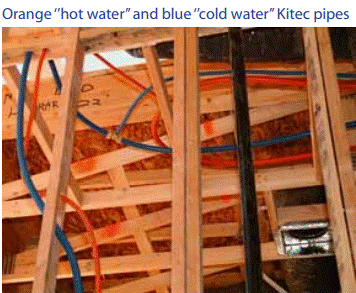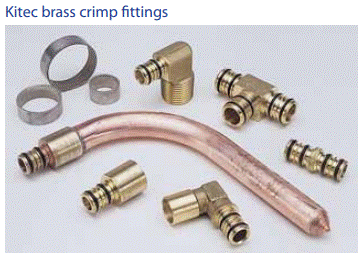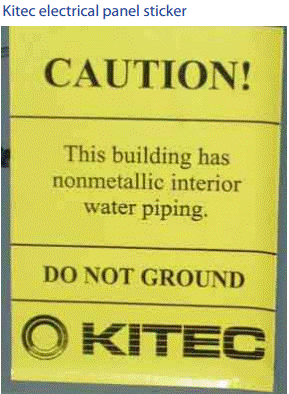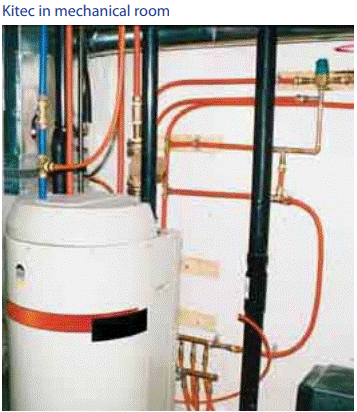About KITEC Plumbing
Published August 7, 2013
Updated July 7, 2025
What do you need to know if you uncover KITEC in your home or a home you’re considering offering on? Read our informative piece on KITEC plumbing.
What is Kitec Plumbing?
Kitec plumbing consists of flexible aluminum pipe between an inner and outer layer of plastic pipe (PEX pipe) with brass fittings. Marketed as a cheaper and easy-to-install alternative to copper piping, Kitec was sold between 1995 and 2007 for potable water, in-floor, and hot-water baseboard heating systems. The sizing of the pipe require fittings from its own manufacturer, IPEX, and these fittings were made with a high zinc content that caused dezinctifying in situations with aggressive water conditions. This in turn could either restrict water pressure or cause the fittings to fail completely, causing flooding and water damage to homes.
In Nova Scotia, Kitec piping is primarily used in hot-water baseboard and in-floor heating systems. There are fewer fittings used in heating systems than potable-water systems, so the potential damage is likely to be lessened, and quicker to spot if fittings fail, because they are more visible than the fittings in potable-water systems.
However, fittings aren’t the only issue. In Nova Scotia there have been problems with the actual pipe disintegrating. One theory is that the pipes degrade from running the hot water system at too high a temperature. Kitec was certified to run at a maximum temperature of 180° F. A typical hot water boiler is set at a high of 170° F. In cases where the coil that heats the water off the main boiler degrades and reduces water temperature, some homeowners increase the temperature of the hot water system past what it was designed to handle, causing the piping to disintegrate.
Where is Kitec Likely to be Encountered?
Kitec was sold between 1995 and 2007, which means it can be found in houses constructed or extensively renovated during this time.
How Do I Identify Kitec Plumbing?
Most Kitec plumbing can be identified by its bright orange (hot water) and bright blue (cold water), which were the most common colours; however, it was also sold in red, blue, gray and black. The pipe is typically marked with one of the following brand names; Kitec, PlumbBetter, IPEX AQUA, WarmRite, Kitec XPA, AmbioComfort, XPA, KERR Controls or Plomberie Améliorée. If fittings are visible, look for Kitec or KTC stamped on them. The terms CSA B137.9/10 or ATSM F1974 could also indicate a Kitec system. Often, the best place to look for the Kitec system is near the hot water tank or in the mechanical room where the pipe connects or exits the walls.
Also look underkitchen sinks or bathroom vanities, where the pipe and/or fittings exit the wall. Look at the electrical panel doors, both inside and out, for a bright yellow or neon coloured sticker stating that Kitec was used in the home and that the electrical system cannot be grounded to it (electrical systems must have a metal ground).
What Do I Need to Know and Do About Kitec When Working with a Buyer?
If your buyer is looking at homes that may have Kitec systems:
- Explain what Kitec plumbing is, that it may exist in the homes being viewed, and what the potential risks are, i.e. the fittings may fail, the pipes may fail, and there may be insurance and/or financing implications.
- Recommend having the home inspected by a qualified home inspector and raise Kitec concerns with the home inspector.
- When writing an offer, add a clause or clauses to the agreement inquiring into the existence of Kitec plumbing and ensure the clause makes provisions for the buyer should the house have a Kitec system. Traditionally, similar clauses have been written for for Urea-formaldehyde foam insulation (UFFI) and asbestos.
While licensees may be able to identify Kitec plumbing, this should not replace the recommendation that a consumer obtain a home inspection.
What do I need to know and do about Kitec when working with a seller?
If you are working with a seller and there is Kitec plumbing in the home, it is important to discuss the potential issues that may arise with Kitec that may affect the sale as well as recommend your seller obtain independent legal advice about Kitec at their earliest opportunity.
In most cases, Kitec is visible upon inspection and therefore not considered a material latent defect—a defect that is not visible or discoverable through a reasonable inspection. Kitec does not have to be disclosed on the PDS unless the seller has experienced problems with the system. If the seller has experienced problems with the Kitec system, it must be disclosed on the PDS.
While at this time, there is no requirement for mandatory disclosure for systems in good working order, if a potential buyer asks about the existence of Kitec in the home, it must be disclosed. Kitec is the subject of a $125 million class action suit in Canada and the United States and the topic of many news stories over the last six years. The first recall on Kitec fittings occurred in 2005. It is reasonable to expect buyers to be aware of and to make inquiries about the existence of Kitec, so it is important to set expectations with sellers. Even if the seller has never experienced a problem with their Kitec system, it may be an issue for potential buyers. If it is, buyers may request a price reduction, or system replacement, or wish to terminate the transaction.
Your seller may or may not be aware of the Kitec class action settlement, which creates a $125 million settlement fund to be used by Canadian and American claimants to pay for the repair of buildings, residences, homes or other structures plumbed with Kitec systems. To be eligible to receive money from the settlement fund, claimants must complete and submit a claim form. Claims can be made regardless of loss and individuals are encouraged to submit a claim even if their system is working properly. The claim filing deadline is January 9, 2020, and claims submitted after this date will be rejected.
If your seller submits a claim, they are required to disclose to potential buyers that a claim was filed and if applicable, the terms of the release (as disclosed in the Agreement). For more information, see the Kitec Settlement website at the following link: http://www.kitecsettlement.com/faq.cfm







